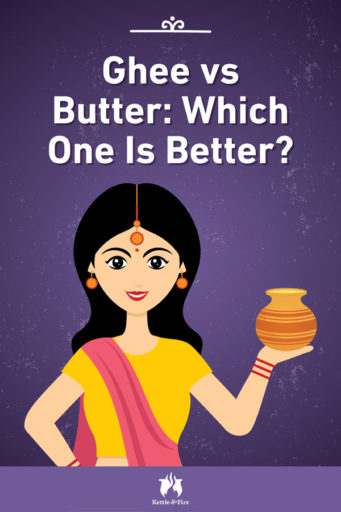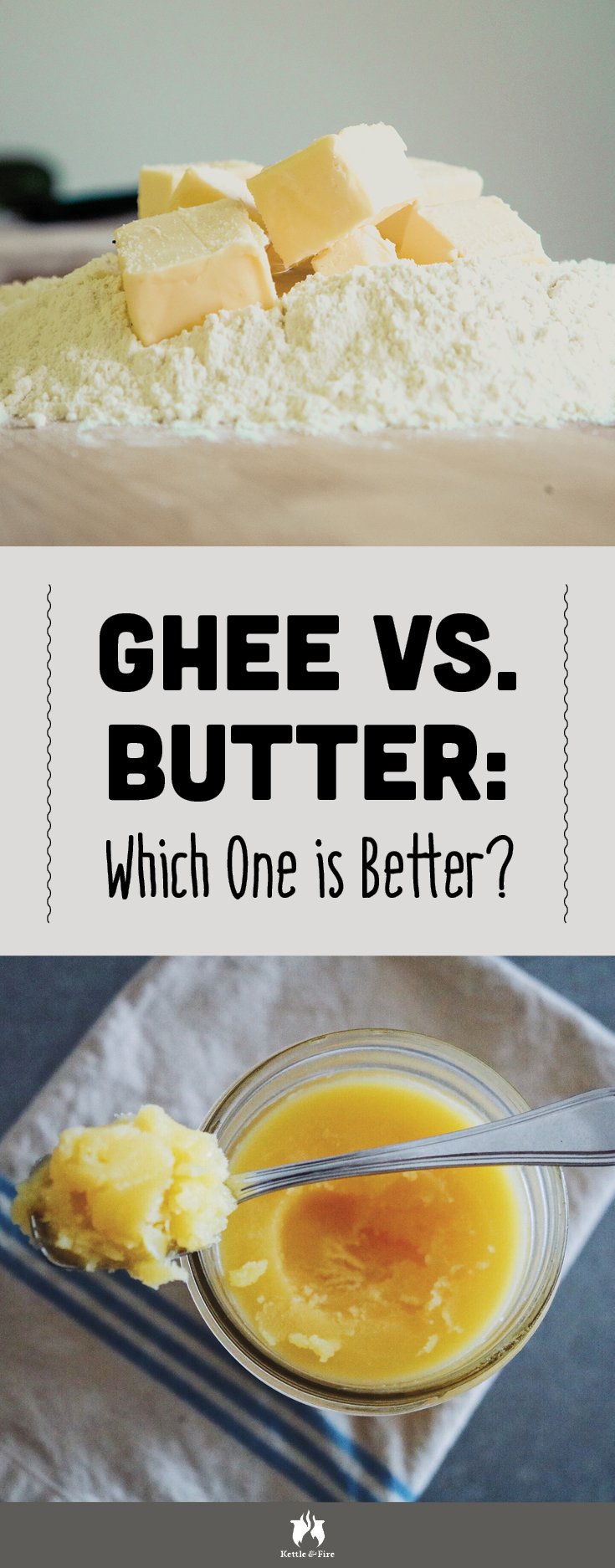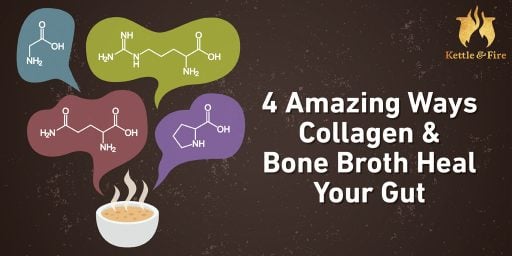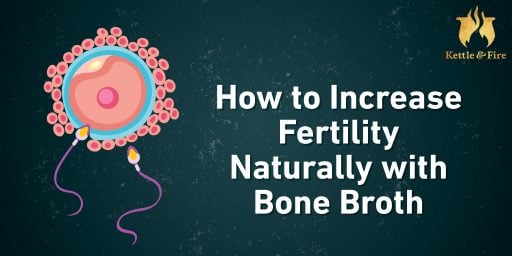Ghee vs Butter: Which One Is Better?

They don’t call ghee “liquid gold” in the Indian culture for nothing.
Ghee, a type of clarified butter, has been used for thousands of years in Indian cooking and Ayurvedic healing.
But only recently has it gained mainstream popularity as a beneficial cooking fat.
If you’re not already familiar with it:
Clarified butter is a fancy term for pure butterfat.
While it has similar properties to regular butter, ghee is like an upgraded version with a richer taste, higher smoke point, deeper color, and more nutrients.
There are various types of clarified butter used in different parts of the world.
Smen, for instance, is a type of fermented, salted clarified butter used in Middle Eastern cooking.
Niter kibbeh is clarified butter spiced with turmeric or cumin that’s used in Ethiopian cooking.
What makes ghee different from these other varieties of clarified butter
is that:
During the rendering process, it’s heated for a longer period of time to allow the milk solids to caramelize, which gives ghee its signature nutty flavor and golden hue.
Today, you can even find ghee flavored with different spices and herbs, such as cinnamon, vanilla bean, cardamom, and ginger — mmmm.
Ghee vs Butter: What’s the Difference?
For starters, ghee and butter are made up of different components. Butter on its own is comprised of butterfat (churned from cream), water, and milk solids. Ghee, which is rendered from butter, is only made up of butterfat.
Unlike butter, ghee and other types of clarified butter contain virtually no lactose and very little casein, which makes them an ideal alternative to regular butter for those with dairy and lactose sensitivities. However, sometimes ghee can contain trace amounts of casein and lactose, so it should still be avoided if you’re truly allergic or intolerant.
Ghee can be used in place of recipes that call for solid fats, such as butter or coconut oil. However, ghee does have a slightly nutty taste, which may alter the flavor of your dish — but not necessarily in a bad way. In fact, some describe the taste of ghee as “more buttery” than butter.
How Ghee Is Made

Ghee is made using regular unsalted butter from cow’s milk (and in some cases, buffalo milk).
When you make ghee, all you’re doing is separating the liquid and milk solids from the butterfat in regular butter. It’s made by cooking and simmering regular, unsalted butter over medium heat for 15 to 20 minutes.
This allows the liquid to evaporate from the butter, and the milk solids to separate and move to the bottom of the pan. Once the milk solids have turned golden brown, you simply strain them through a cheesecloth, and voila: You’re left with ghee.
Benefits of Ghee
1. Ghee Contains CLA
When made from butter sourced from grass-fed cows, ghee is rich in CLA (conjugated linoleic acid), which is a fatty acid that may reduce inflammation (1).
Research has also shown CLA from food sources to be beneficial for promoting sustainable weight loss and supporting cardiovascular health.
In other words, CLA is a fatty acid you want to have in your diet.
2. Ghee Is a Good Source of Butyric Acid (BTA)
Butyric acid is a short-chain fatty acid that sounds similar to one of the foods it’s found in: butter. Of course, this means butyric acid is also found in ghee, and it’s one of the reasons why ghee is nicknamed liquid gold.
Butyric acid is an essential nutrient for the digestive system because it helps maintain healthy cells throughout the GI tract, and provides energy to the cells in your large intestine (2). It’s found in other animal fats and vegetable oils. Healthy digestive tracts also produce it during digestion while breaking down fiber from carbohydrates.
3. Ghee Is Rich in Vitamins A, D, E, and K
Let’s face it: We could all do with a few more vitamins and minerals in our diet. Ghee is a source of the essential fat soluble vitamins: A, D, E, and K.
If you live in a cooler climate that doesn’t get sun year round, chances are you may not be getting enough vitamin D, which plays a critical role in calcium absorption, and supports healthy bones and teeth (3). Vitamins A and E also help support immunity, which may be why ghee is often added to the warming Ayurvedic drink, golden milk.
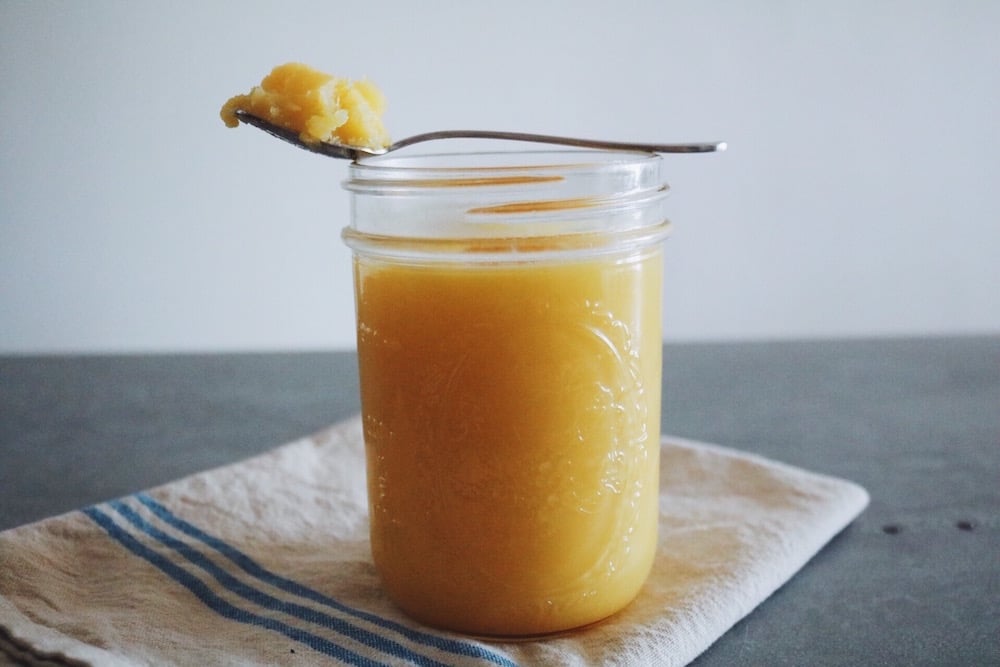
4. Ghee Contains MCTs
Medium-chain triglycerides, or MCTs, are medium chain fatty acids that your body can use for energy right away. MCTs are found in fats such as ghee, coconut oil, and palm oil.
Unlike long-chain fatty acids — which are found in most vegetable and animal fats and take longer to digest — MCTs are fairly quick to digest due to their shorter chain of fatty acids, and get sent straight to your liver to be metabolized. This is one reason why they may help boost energy levels, and don’t get stored as fat (4).
You may have heard that glucose is your brain’s preferred fuel source, but research shows your body runs equally as well, if not better, on ketones produced from fats (5). This is why some people experience increased cognitive function, focus, and concentration when they add more MCTs (list of keto foods) to their diet. MCTs, therefore, are a popular fuel source for athletes.
If you’ve ever heard of bulletproof coffee or the ketogenic diet, you know what we’re talking about.
5. Ghee Has a High Smoke Point
As mentioned above, ghee has a higher smoke point than most fats, which makes it perfect for cooking with. This is because pure butterfat has a smoke point of 450 F. By comparison, regular butter and coconut oil only have a smoke point of 350 F, while extra virgin olive oil has a smoke point of 320 F.
Why does the smoke point of a cooking fat matter? The smoke point is the temperature to which the fat can be heated to without having its nutrients destroyed. This is also the point that a fat can be heated to before it will begin to smoke (hence the name).
Aside from being a kitchen hazard, when you heat a fat or oil beyond its smoke point, it can form free radicals, which are molecules that can cause damage to your cells (6).
This is why it’s always recommended to cook with a fat that has a higher smoke point. While butter and coconut oil are acceptable for medium and medium-low temperatures, ghee can withstand higher heat, which makes it a top choice to cook with — and with fewer risks.
6. Ghee Is Paleo Friendly (Thanks to Low Casein and Low Lactose)
The paleo diet, which aims to support digestive health, recommends avoiding dairy products because many people are sensitive to lactose — the milk sugar found in dairy — and casein, the main protein in milk.
With the absence of milk solids, the casein and lactose content in ghee and other types of clarified butter is often not high enough to cause digestive problems. In fact, many sources say it’s actually well tolerated by people with mild dairy sensitivities (not to be confused with full-blown dairy allergies).
While the dairy and paleo debate is rather subjective, most health experts agree that if you don’t have a true dairy allergy, small amounts of ghee and grass-fed butter are beneficial on the paleo diet.
Is Ghee Better Than Butter?
In a nutshell, here’s how ghee vs butter compare in terms of digestibility, nutritional value, flavor, and cooking safety.
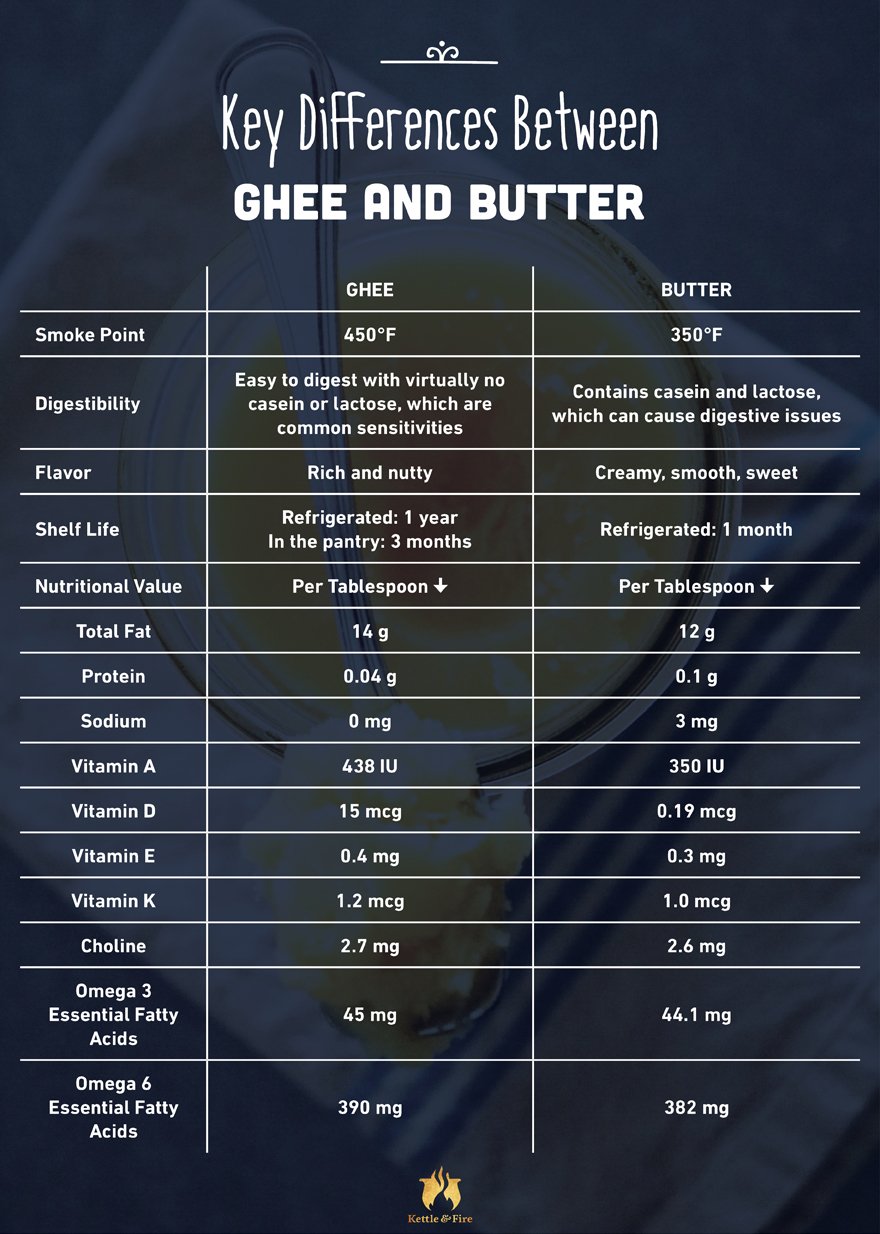
How to Add Ghee to Your Diet (Other Than as a Cooking Oil)
There are so many ways to add ghee to your diet (other than cooking with it). You can use it for baking, drizzling on top of steamed veggies, or as a popcorn topping. You can even stir it into a warm mug of bone broth.
One of our favorite ways to eat ghee is actually to drink it by adding it to coffee. When we’re not drinking bone broth, this is our other favorite pick-me-up to sip on during the day. Best of all, this ghee coffee recipe contains collagen, another gut-supporting ingredient. (Not to mention, it tastes like heaven!)

Ghee and Collagen Coffee Recipe
INGREDIENTS
- 1 cup fresh organic coffee
- 1 tablespoon ghee (sourced from grass-fed cows)
- 1 tablespoon collagen peptides (sourced from grass-fed cows)
- 1 teaspoon pure vanilla extract
- 2 tablespoons unsweetened vanilla almond milk (or more to taste)
INSTRUCTION
Place all ingredients in a blender and blend until frothy. Drink immediately.
Going Forward With Ghee
As you can see, ghee and butter have similar benefits. However, when you swap butter for ghee, you get the added benefit of a higher smoke point when cooking and frying. There’s also the plus of removing the milk protein, which can cause digestive problems in those who are sensitive to dairy.
Ghee also provides more nutritional bang for your buck because it’s higher in butyric acid, MCTs, and vitamin A than butter. You can buy ghee at your local health food store, or better yet, make your own ghee at home. It’s way less expensive to render ghee yourself, and it only takes 25 minutes.
Pin for later:
